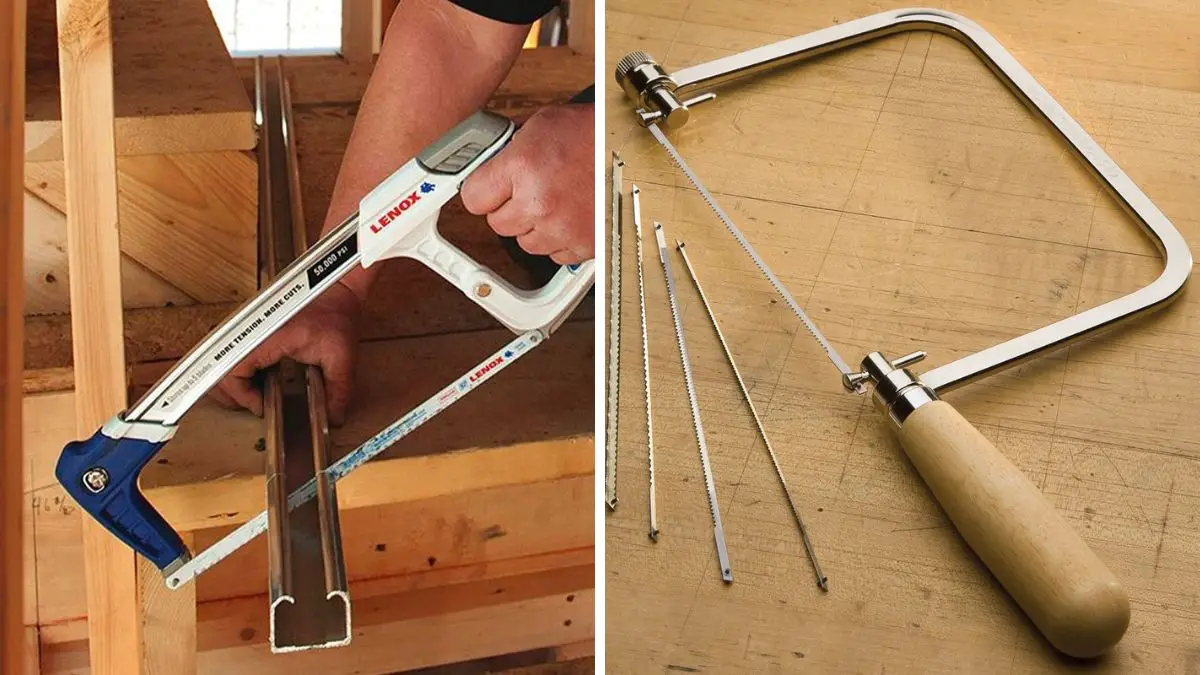A coping saw and a hacksaw are essential tools found in a carpenter’s toolbox. But which one is the more useful tool, and can they both be used interchangeably? Today, we’ll be talking about the differences between coping saws and hacksaws!
What Is a Coping Saw Used For?
Coping saws have a metal frame with a narrow and thin blade stretched across it. The blades may be fine or coarse depending on their use and typically have 12 to 15 teeth per inch. Coping saws are used to make turning cuts on wood, plastic, or metal, depending on which blade has been selected for use.
Coping saws are designed so that they can easily be maneuvered to make tight cuts on wood or any other material they are being used on.
Are Coping Saws Hard To Use?
Coping saws are lightweight with thin blades and plastic handles, perfect for carving wood and making tight cuts. Coping saws are not very difficult to use, but by following some simple steps, the process can be simplified.
- First, choose the correct blade according to what you’ll be using it for and install the blade safely.
- Next, secure the material that needs to be cut with clamps. This will prevent the material from slipping and will create clean cuts with precision.
- You may trace a line on the wood that you need to cut. Always place the saw’s central teeth at the beginning of the line and push down with short strokes to make the cuts.
- Hold the saw perpendicular to the wood and keep sawing. You may turn the handle as required to make the turns. The saw’s blades may need to be changed as they are thin and can often break while sawing.
What Is A Coping Saw Best For Cutting?
Coping saws are best for making coped joints, cutting shapes, creating tight turns, finishing the ends of dovetail joints, and cutting tiles.
Do You Push Or Pull A Coping Saw?
A coping saw works better on the pull stroke or the backward stroke. Although this is a bit controversial as many woodworkers and people argue that they prefer one way over the other. Many carpenters prefer the push stroke more, while some believe that the pull stroke is the way to go.
Ideally, you can decide which movement works better to suit your purpose depending on your use, as both are correct.
What Is A Hacksaw Used For?
Hacksaw frames are made out of metal and have a c shape. The open end has a thin blade running across it, ranging from 6 to 12 inches. The metal frame itself can be 6, 10, or 12 inches long. The blade is removable and, since it can’t be resharpened, needs to be changed once it becomes blunt.
Plumbers and mechanics use hacksaws to cut metal such as steel, copper, aluminum, and brass. It is also used for cutting plastic pipes and PVC. Hacksaws are generally used for cutting materials that are harder than wood but cannot be used to cut through stone.
Hacksaws come in 4 types to be used in a range of applications:
- The Full-Sized Hacksaw
- The Junior Hacksaw
- The Mini Hacksaw
- The Power Hacksaw
Does A Hacksaw Cut On The Push Or Pull?
Hacksaw blades must be mounted with their teeth facing forward to work best on the push method of the forward stroke rather than the pull or backward stroke. Hence the push method must be used when using a hacksaw.
Can a Hacksaw Cut Plywood?
Yes, a hacksaw can be used to cut plywood, but since hacksaws are meant for cutting harder materials such as metal, using them to cut plywood may not be the best idea. It would take too long, and the process would be inefficient.
What Is The Difference Between A Hacksaw And A Coping Saw?
- A coping saw has teeth pointed away from the handle and therefore works better on the pull stroke
- A hacksaw works more efficiently on the push or forward stroke
- The blades of a coping saw are thin and flexible
- The blades of a hacksaw are much thicker as they are used to cut through harder materials
- The teeth of a hacksaw blade are much longer than those on a coping saw blade
- Since a coping saw can be used in controlled movements, it is better suited for more intricate work
- Hacksaws are used to cut harder materials such as metal, plastic, and PVC
- Coping saws are specialized to make tight cuts on wood, make coped joints and create curves in the wood
- Coping saws have skinny blades and can be maneuvered easily to change the direction of the cut
- Coping saws can be used to cut circles, while hacksaws cannot
- Coping saws are lighter in weight
- Hacksaws are heavier by design
- The blade on a hacksaw is wider and thicker with many teeth per inch of the blade allowing it to cut through thicker materials easily
- Hacksaws are not suited for intricate work and are ideal for cutting tiles and plywood.
- A coping saw is a more versatile tool than a hacksaw
Conclusion
We hope that we’ve been able to settle the hacksaw vs. coping saw debate. The hacksaw and the coping saw are valuable tools to have, and both are designed for specialized purposes, and it is not recommended that they be used interchangeably. Each saw can be used depending on the nature of work required.


